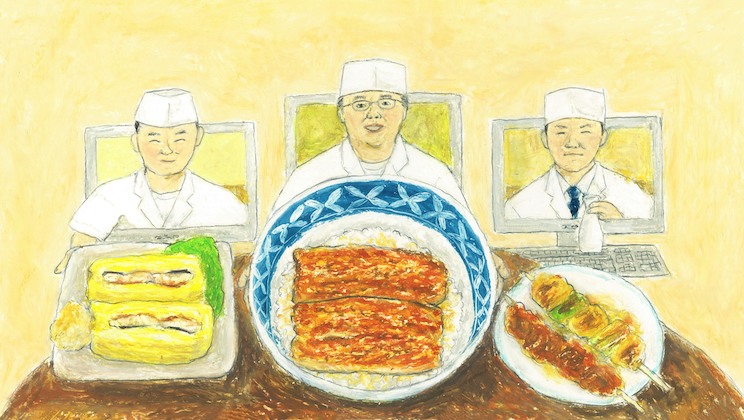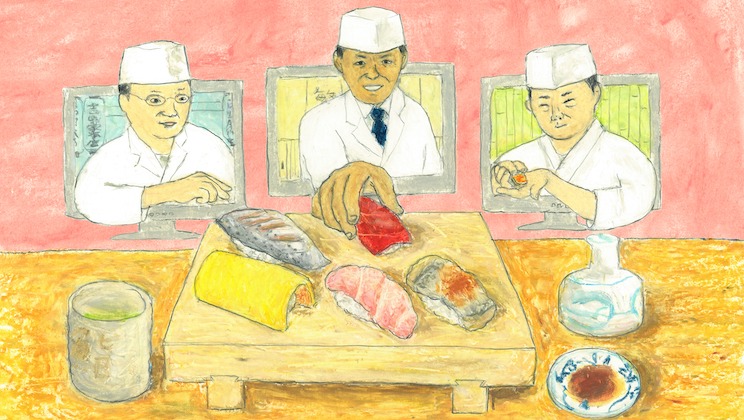A Place That Harmonizes With the City, and Forms Connections With People. The UDS and Blue Note Japan Vision for the “HAMACHO HOTEL.”
A Place That Harmonizes With the City, and Forms Connections With People. The UDS and Blue Note Japan Vision for the “HAMACHO HOTEL.”

Nihonbashi Hamacho, a neighborhood that has grown more “residential” as it gains housing, but which retains the atmosphere from longstanding businesses with a locally-rooted culture and history. The new “HAMACHO HOTEL” saw its inception in this area in February 2019, becoming the area’s new symbol. The hotel’s planning, interior design, and operations are handled by UDS Ltd., a company known for its urban development work in lodging facilities, commercial complexes, public facilities, and more. How does the “HAMACHO HOTEL” work to harmonize with the people in the city? To answer that, we spoke with Mr. Kengo Maeda, Manager of the HAMACHO HOTEL in the Hotel Management Business Group of UDS Ltd., as well as Mr. Takayuki Yamamoto of Blue Note Japan, the operator of “SESSiON,” the main dining establishment in the hotel.
Two companies that aspire toward “harmony with the city” using their own respective approaches
-First, please tell us about business at UDS.
Mr. Kengo Maeda, UDS (below: Maeda): As a company, UDS works in business planning and facility design, and on into operations. There are a lot of companies that specialize in planning and designing facilities and buildings, but most don’t operate them. The “HAMACHO HOTEL” is another case where we weren’t just involved in design; we also participated in planning, and even operate the hotel. That lets us show the intent of the design and planning stages during operations, and also produces a virtuous cycle where feedback from the customers and staff helps improve our next plan or design. Starting with hotel examples like the “MUJI HOTEL GINZA” (Tokyo) and “the rescape” (Okinawa), we have worked on 64 sites within Japan and abroad as a group, including coworking spaces, public facilities, commercial complexes, housing, and more.
-How do you feel, working against a background of one-stop solutions for planning, design, and operations?
Maeda: We hold “providing options for new value creation, and taking responsibility for their futures” as our corporate mission. We don’t just plan and design groundbreaking, exciting facilities, in a hard sense, we also operate them on the soft side. I think that continuously building something up is a vital point in the “urban development” we talk about at UDS.
We are also distinct in considering “what the city needs” and “how to enhance the city’s charm” regardless of the industry. As a result, a lot of our plans combine a variety of types of value into compound forms. We planned the “HAMACHO HOTEL” as a compound facility, too, combining a hotel, restaurants, and chocolate shops.

HAMACHO HOTEL Manager, Mr. Kengo Maeda
-And Blue Note runs the restaurant section. Please tell us about Blue Note’s business, too.
Mr. Takayuki Yamamoto (below: Yamamoto), Blue Note Japan: At Blue Note Japan, three major pillars support our business – entertainment, food and beverage, and bridal business. I think a lot of people know about our entertainment business, but we operate live shows, event planning and staffing, and food and beverage industry business centered on six cafes and restaurants, with our Minamiaoyama jazz club “BLUE NOTE TOKYO” foremost. In bridal business, we are focused on company-owned stores.
-I think what all of these business endeavors share is that they “create a place that people gather.” What points do you keep in mind when creating a store?
Yamamoto: Our vision contains the key words “we want to be there,” and we are always aware that “we want to be there,” and that “we want to share time here” in the spaces we create, no matter where we open a store. That is why our sense for “harmonizing with the city” is quite strong, and shares a lot with the stance at UDS. We wanted to create a place where people, music, and food connect, producing community.

Mr. Takayuki Yamamoto of Blue Note Japan
Hamacho is the “Brooklyn of Nihonbashi.” It’s a borough that retains a downtown feel, and human connections.
-Could you tell us about the chemistry between Nihonbashi Hamacho and your business, and some of the area’s charms?
Maeda: We were actually motivated to join in planning for this project when a company promoting urban development - Yasuda Real Estate - spoke with us. I think the appeal of the Hamacho area is its location, first of all. It’s just two kilometers from Tokyo Station, with three subway stations and four lines between them, and close to the Tokyo City Air Terminal at Hakozaki. It has much better transit access than its image implies. Despite this location, there are still a lot of “out of reach” places in the Hamacho area. It has high potential as a part of the city, and I think it deserves a higher appraisal overall.
Also, Hamacho is distinct in how it still has a downtown atmosphere, and the right sense of distance and closeness among people who live here. You tend to think of Asakusa and other areas that are undergoing a shift into tourist zones, when you think of downtown, but Hamacho has a different sort of charm. It’s a sense of being “the kind of downtown where you can feel the everyday life of the residents,” you might say. I think that sort of area will rise in popularity among foreign visitors, going forward, and sense a huge amount of potential from that.
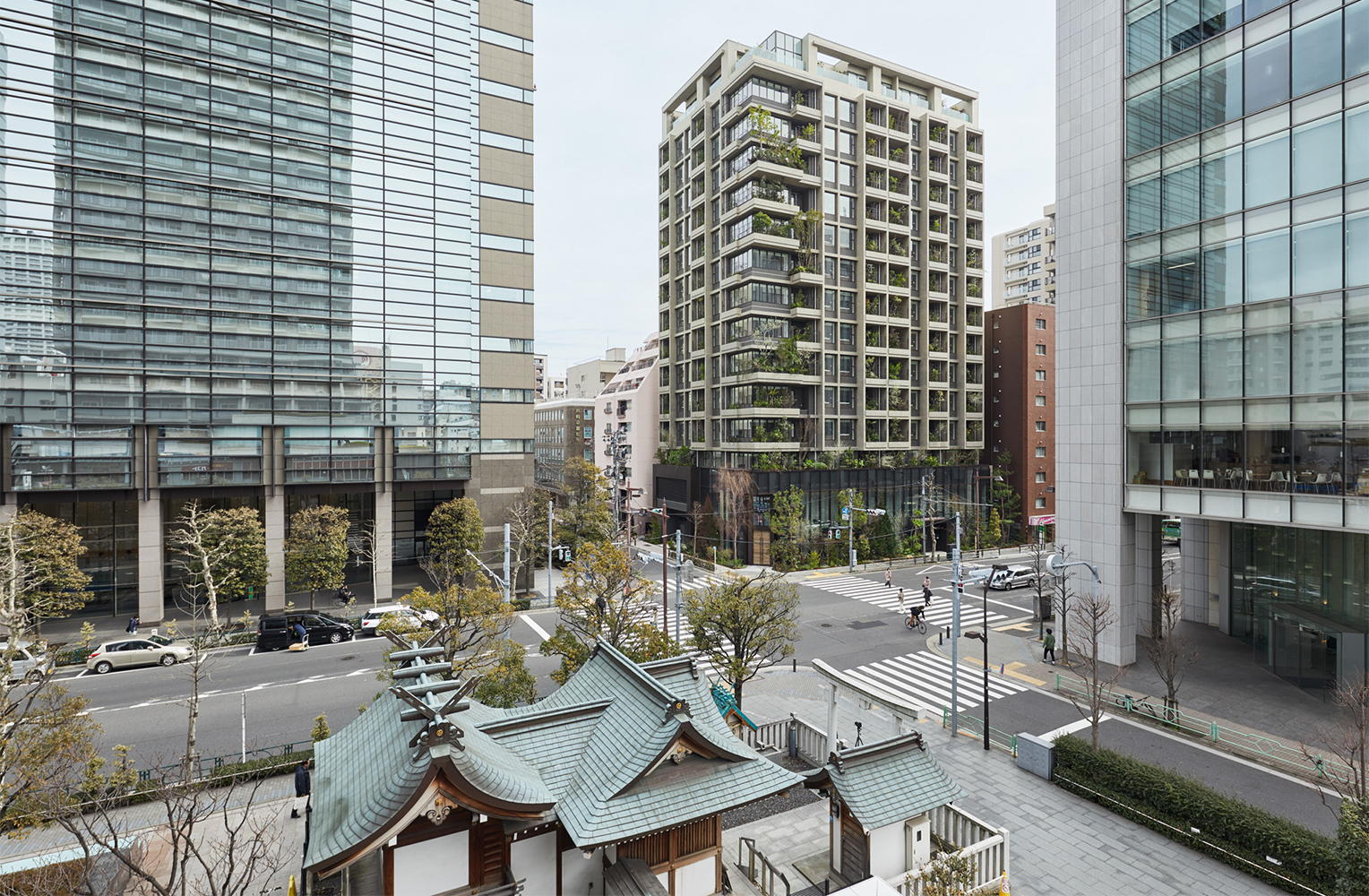
Nihonbashi Hamacho, where the vibrant Edo period atmosphere mixes with modern architecture (Photo credit: Nakasa and Partners)
Yamamoto: We also took an interest after Yasuda Real Estate invited us to “try opening a store in the HAMACHO HOTEL,” but the truth is that we didn’t know about Hamacho as a city, before then. But we visited the city many times in considering the idea, and felt it was a great area, with strong human connections and community. Since Blue Note Japan also places a high value on human connections, we felt a strong chemistry there.
We also like the city’s atmosphere. If you compared all of Nihonbashi to New York, the western Nihonbashi-muromachi area would be Manhattan with its office buildings and commercial complexes, while Hamacho in the east has more of a Brooklyn atmosphere. And since Blue Note Japan began as a company that likes opening stores in “areas set to take off,” we felt that Hamacho was also a perfect fit in that regard.
-As you’ve gotten involved with Hamacho as a city, do you have any stance on how the “HAMACHO HOTEL” should be valued?
Maeda: I want to hold to a position of us making inroads into the community, instead of just taking in guests. There isn’t a lot that we have accomplished yet, concretely, but in addition to participating in local events, I want to attempt to develop future “HAMACHO HOTEL” events to expand out of the hotel and into the city itself.
As a city with strong human, corporate, and business connections, I think it would grow even more active if we got a lot of people involved in something. In order to try to pull that sort of activity off, I want to shake off our image as “some company that made its way to Hamacho lately,” and become “a Hamacho citizen” right away. Cultivating a sense of “everyone being in it together” is critical in urban development, and I think it could make us all event stronger here in Hamacho.
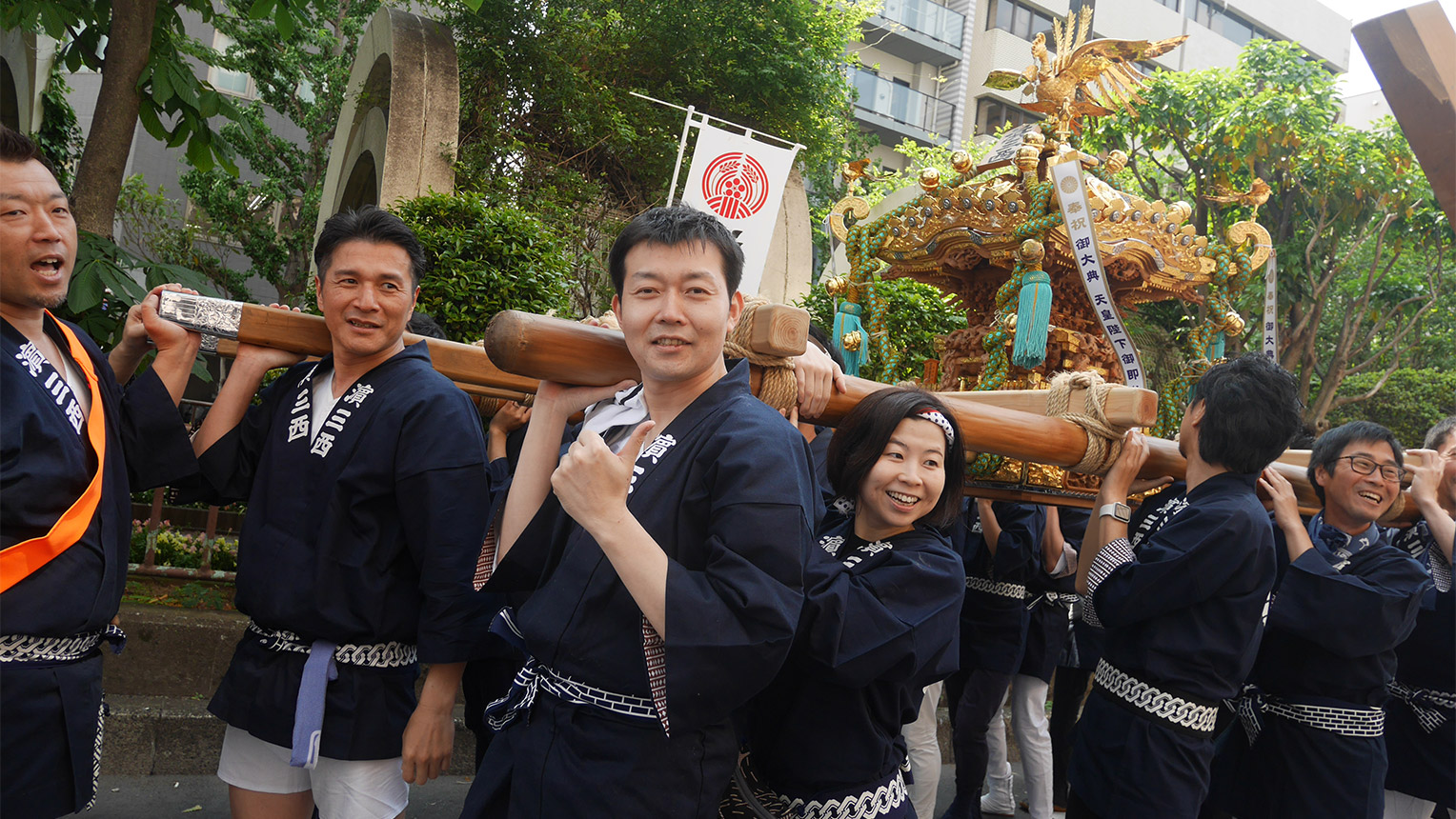
Mr. Maeda joined in a festival in May, carrying the Omikoshi shrine
-How do you think about connections with the city at “SESSiON”?
Yamamoto: Since we first opened, I have emphasized a stance of “serving food that suits the city, while maintaining the Blue Note Japan style.”
“SESSiON” actually has a lot of regular customers, and we work to take in a lot of their opinions on the restaurant. All of our staff come together to think about how to please our customers, based on those opinions, and we actively incorporate them into the actual menu and operations. We emphasize giving the restaurant a sense of originality by holding this cycle of processes. I think that these “sessions” with the chefs, bartenders, staff, and customers help improve the restaurant. A “session” can be something exciting or thrilling, and we want to let free imaginations touch off a wide range of that kind of session.
The HAMACHO HOTEL’s focus on “craftsmanship”
-The “HAMACHO HOTEL” seems to draw a lot of inspiration from the craftsmanship and culture related to craftsmanship that Nihonbashi has fostered.
Maeda: The Hamacho urban development concept is “handmade” and “a city where you see greenery.” I think that an understanding of the cultural and historical background is critical in creating structures that take root in an area. For example, this area used to be a city filled with artisans, and was a site for popular performances like shibai plays and joruri puppet shows. Given that sort of background, I wanted to emphasize the handmade part of the concept. I also thought of a wide range of plans that we could develop on the topic of what the “HAMACHO HOTEL” can do to convey the excellence of Japanese handmade craftsmanship to the world – starting from Hamacho.
For example, the “TOKYO CRAFT ROOM” is one symbolic plan that embodies this concept. In this project, we matched Japanese artisans with Japanese and foreign designers, creating new ideas using Japanese craftsmanship techniques. The “TOKYO CRAFT ROOM” is a room in the “HAMACHO HOTEL” where you can actually use the items produced. For the record, the mugs made in the first round are used in all of the guest rooms. I think it’s vital to actually hold and taste things to experience the quality of hand-crafted works.
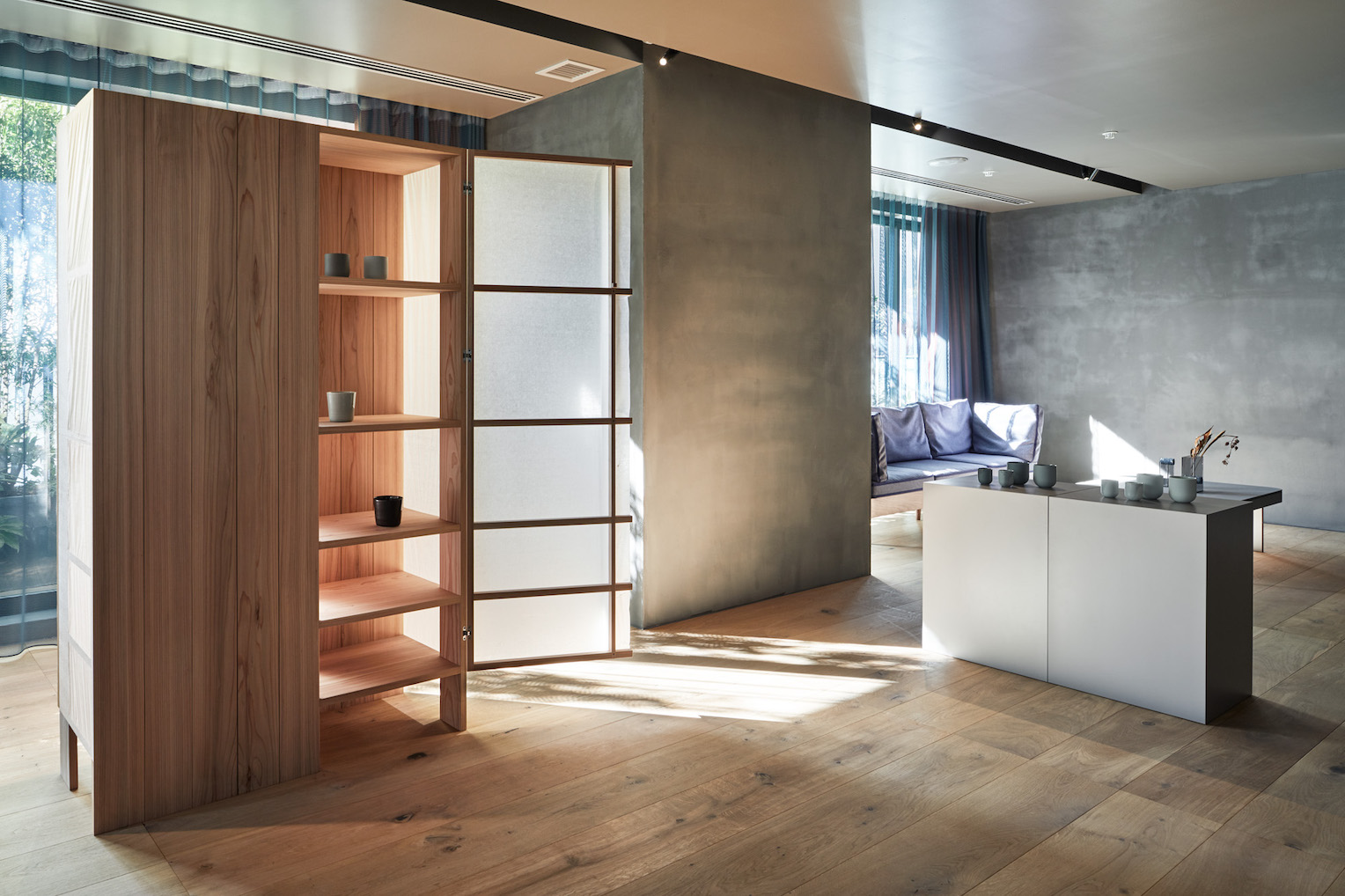
The HAMACHO HOTEL “TOKYO CRAFT ROOM” (Photo credit: Nakasa and Partners)

Mugs and hotel-original leather crafts produced for the “TOKYO CRAFT ROOM”
Seamless spaces give rise to all sorts of interactions
-Please share the points about the HAMACHO HOTEL and SESSiON that you want people to focus on, respectively.
Maeda: As a manager, it’s service, as you might expect. The “HAMACHO HOTEL” actually doesn’t proactively hire people with hotel experience. I think we can produce groundbreaking ideas that a conventional hotel wouldn’t, by hiring lots of inexperienced staff and avoiding fixed perceptions. Our ideal style of service is “friendly and polite.” We emphasize friendly more between those two, and I would be delighted if everyone enjoys the casual, approachable atmosphere we aspire toward.
Of course, I also want people to notice the space itself. We have 170 guest rooms, designed with keywords like “homemade,” “Japanese,” and “modernism.” We also incorporate a lot of greenery on the balconies, for an intimate atmosphere. I think just experiencing it for a single day would help you understand the comfort we offer more fully.
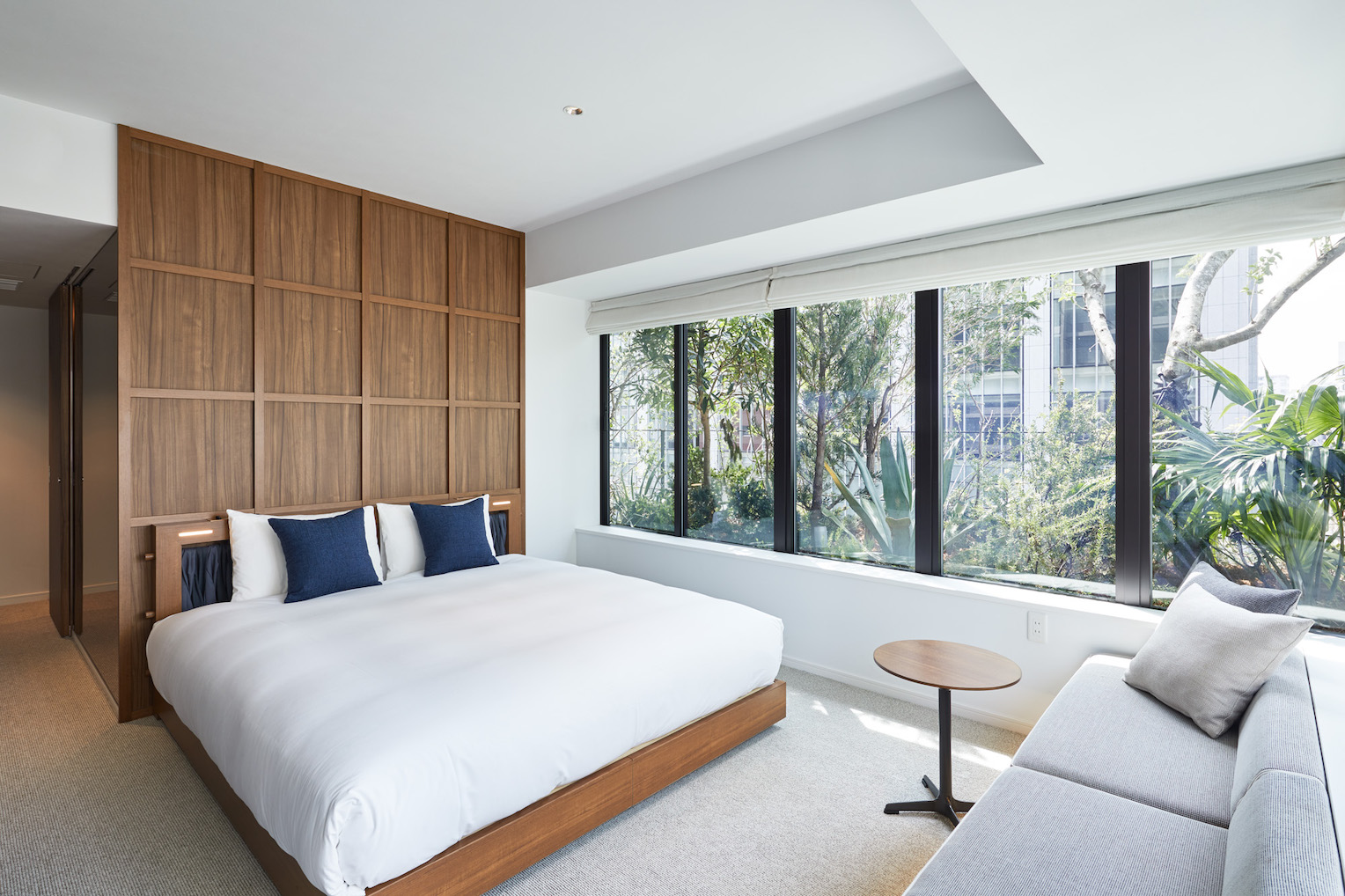
A guest room with handcrafted accents and a sense of greenery from the balcony (Photo credit: Nakasa and Partners)
On our lobby floor, we have a distinct seamless design from “SESSiON” to the front desk, for an open atmosphere. Rather than adding partitions for the restaurant, we wanted to generat all sorts of interactions with a seamless space.

The lobby floor, seamlessly connecting SESSiON with the front desk
Yamamoto: Conventionally, most restaurants that open up in hotels as tenants are partitioned off with walls. But that makes them almost separate worlds. This hotel uses a unified space in its design, which gives rise to diverse interactions, like you’d get with foreign and local guests drinking at the same bar.
And for our restaurant, as you’d expect, I want people to focus on our live events. The speakers in the restaurant are the same models used in “BLUE NOTE TOKYO” and other locations, and with the extremely-high roof, we have great acoustics. Live shows provide a place for guests to interact with locals, and also a chance to experience music. You can try a local delicacy out in the city, then come to “SESSiON” to enjoy a live show over drinks. We welcome that sort of visitor, as well.
Harmonizing with the local residents while continuing the challenge
-Finally, what kind of presence do you want to have in Nihonbashi Hamacho in the future, or what sorts of challenges do you want to take on?
Maeda: Of course, I want to contribute to development for Nihonbashi Hamacho, and the ultimate goal is for people to someday say, “you mean Hamacho, with the HAMACHO HOTEL?” Toward that end, we want to eventually expand out of the hotel, and not just provide services internally. I think it would be great if we could advise guests on the city’s charms, and generate interactivity by involving the local residents and local store owners. I want to enliven the Hamacho area even more, in that way, and create a sense of unity with the surrounding Nihonbashi area. Of course, UDS can only accomplish so much on our own, so I hope to work with a diverse range of companies and the local residents on that.
Nothing would make me happier than for us to continue taking on the challenges we can, and for everyone who lives here in a decade to say “the city has changed for the better since they built the HAMACHO HOTEL.”
Yamamoto: We would also be delighted if people said things like “the city is more fun since they built SESSiON,” or “the HAMACHO HOTEL brought us SESSiON.” Toward that end, I think it is important for us to always be “a place with something to share,” using the musical side of “SESSiON” as well. Other group restaurants run cooking classes and wine tastings, so I want to use that sort of experience when considering what sorts of events we could share that everyone in the city would enjoy. I feel like we have a lot of options, and want to on our challenges one after the other, while discussing our options with Mr. Maeda.
The area is home to a lot of older people, but everyone here is quite healthy. I want to provide music for everyone to enjoy, often, and think it would be great if we produced a lot of “music-fluent” retirees. Nihonbashi Hamacho also has performing arts culture in its roots, with the Meiji-za Theater at the forefront. I think that sort of atmosphere produces artists for live performances. I think it would be wonderful if we could create the kind of magical place where guests and artists learn from each other.
For the record, I also joined in for the Hamacho Bon-odori dance festival, and it’s rare to see Bon-odori dances get that lively, these days. I hope the powerful local energy works well with “SESSiON” in collaborations. We sometimes work on music festivals at Blue Note Japan, so I hope to have a chance to cut loose with the locals at one someday.

Interview/Text: Yusuke Iguchi
Photography: Daisuke Okamura
HAMACHO HOTEL
Address: 3-20-2 Nihonbashi Hamacho, Chuo-ku, Tokyo, 103-0007, Japan
Directions:
6-minute walk from “Hamacho” Station (Exit A2) on the Toei Shinjuku Line
6-minute walk from “Suitengumae” Station (Exit 5) on the Tokyo Metro Hanzomon Line
9-minute walk from “Ningyocho” Station (Exit A2) on the Tokyo Metro Hibiya Line
10-minute walk from “Ningyocho” Station (Exit A3) on the Toei Asakusa Line
HAMACHO DINING & BAR SESSiON
Address: HAMACHO HOTEL 1st Floor, 3-20-2 Nihonbashi Hamacho, Chuo-ku, Tokyo, 103-0007, Japan
Business Hours:
Mornings: 7:00 – 10:00
Monday – Saturday: 11:30 – 23:00
Sundays and Holidays: 11:30 – 21:30
Phone number: 03-3666-3303
